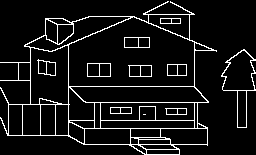Shirley Jackson, 1959
the third book in the visitor recommendation series; This is, as the title pretty strongly suggests, a haunted-house story. As I started in I wondered how this was going to work; presumably a big part of the point would be to establish a spooky atmosphere, and it seemed to me that atmosphere is pretty hard to convey in prose. In film you've got a lot of ways to play with the mindset of the audience. One is music; you can get viewers feeling spooked just by playing the right chords, regardless of what's happening in the story. Another is lighting; whether a house is welcoming or bleak is largely dictated by its lamps. I remember that in 1994 I went to visit some friends and the only lights they had on were these grim fluorescents in the kitchen, and in a few minutes I kind of wanted to die. I felt like everyone in the house hated me and that I had no hope of ever finding even a brief moment of happiness. Having had that experience, I could certainly buy into the notion of being driven crazy by a house. But it struck me as the sort of thing that could only be conveyed through these sorts of low-level hacks into the mechanisms of emotion — not through words. And unfortunately, reading the book didn't change my mind. One of my evaluative patterns notes that my eyes tend to bounce off descriptive passages, which is a symptom of the fact that I don't have a very good sensory imagination. I could intellectually apprehend that the characters were hearing something pounding on the door, or feeling a cold spot in the room, but as I was merely being told about it rather than experiencing it for myself, it didn't do anything to scare me. Maybe an audiovisual would help? This book has been adapted for the screen twice, so after I finished it, I watched the movies:
The Haunting The '63 movie is much more faithful to the book than the '99 one, but both include an early scene from the book in which the characters Eleanor and Theodora huddle together in terror while something bangs on their bedroom door. And... yeah, nothing. Elizabeth and I were both utterly unmoved. And it's not because nighttime sounds aren't alarming in real life! When I'm drifting off to sleep I am constantly sitting bolt upright at one sound or another — not because of g-g-ghosts, but for fear that that crash of glass outside is someone breaking into my car, or that that soft scratching noise is a mouse in the kitchen. And I hate when people knock on my door, even at 2:30 in the afternoon — it makes me jump out of my skin. But even with a soundtrack blaring that I should be freaking out, the pounding in the movies had no more effect on me than that in the book. This got me thinking about whether I'd ever been scared by anything in a story. Horrified, certainly — as recently as Black Swan I was covering my eyes rather than watch Nina tend to her split toenail or tug at her cuticles. And worried for a character I like, sure — when I watched The Sopranos I spent almost a whole season fretting that the FBI agent who goes undercover as Adriana's gal pal would end up getting whacked. But I don't think that the basic idea behind the genre — putting characters in scary situations so that the audience will share their fear — works on me. I just don't project myself into stories to that extent. I guess I should say something about the psychological angle, as the book is frequently filtered through Eleanor's stream of consciousness and is less about poltergeists than about her mental breakdown in response to them — has she been possessed by the spirit of the house, or was she just that fragile? That sounded pretty interesting as I typed it, but the truth is that I found a lot of the book hard to follow. Phrases swirl around in Eleanor's head but don't seem to add up to much. And the relationships among the characters shifted in ways that made me wonder whether I'd missed some pages. For instance, Eleanor and Theo initially hit it off quite well, and then abruptly they're feuding, and I'm like, wait, when did this happen? I gather that this sense of fragmentation was deliberate, meant to reflect that Eleanor was losing her grip on reality or something — but that meant that I lost my grip on the logic of the story and sometimes even on the nuts and bolts of what was happening. Which I guess means that it's time for another pattern:
The filmmakers also seem to have found the psychological aspect of the story difficult to translate. As noted, the '63 movie is pretty faithful to the book, leaving us with some fairly risible sequences that go: Shot of a house! Dissonant horns! Look at the stonework around that window! Eleanor starts to reel! She's about to topple off the balcony! Another character grabs her! She weeps about this awful house! Shot of... a gabled roof! More horns! At one point the house is supposed to be "fighting" with Eleanor and her struggle against the curtain brings to mind nothing so much as Frank Drebin's battle with the pillow in The Naked Gun. The '99 movie avoids this kind of silliness by discarding the psychological angle altogether in favor of a different kind of silliness, making Eleanor the descendant of a serial killer of child laborers who has turned into a big CGI monster whom she must defeat by shouting at while hitting an animate stone bird with a baseball bat. I said I thought this story probably required low-level hacks, but this was lowbrow hackwork. Not the same thing!
|




